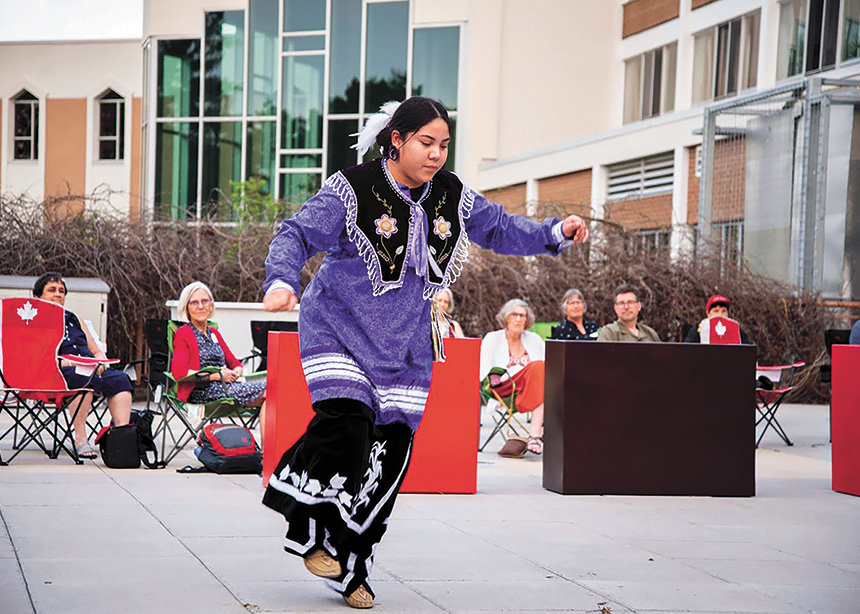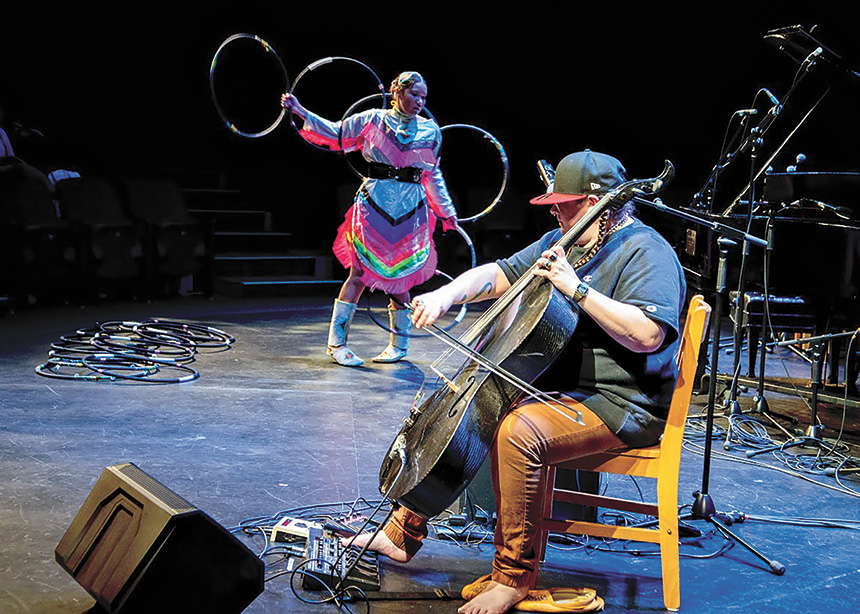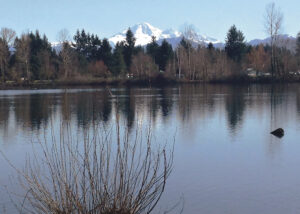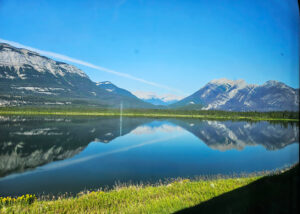I didn’t realize what I was signing up for when I agreed to write about Indigenous-Mennonite Encounters in Time and Place, a conference held at Conrad Grebel University College in Waterloo, Ont., from May 12 to 15.
It was an intense weekend of learning, emotion, sharing, dancing and stories. The conference started with a mix of relief and excitement as the organizers described the long road to the opening of the conference, three years in the making and delayed by the pandemic.
Despite challenges, the conference was remarkably well organized and ran with a smoothness that testified to deep thoughtfulness and a great deal of hard work behind the scenes.
We are our stories
Mim Harder of the conference listening team evoked the wisdom of Ojibwe author Richard Wagamese: “We are our stories,” and keynote speaker Lori Campbell reminded us that stories shape who we are and how we interact with others.
So many stories were shared, honoured, brought to light and deconstructed during our time together on Haudenosaunee, Anishnaabe and Chonnonton territory. I am only one voice of many who attended and I have but a thousand words to share my perspectives of some of the rich, uplifting and deeply unsettling stories of this landmark conference.
Cherished stories unsettled
Mennonites carry many cherished stories with us of our “origin story” on this land. (I didn’t grow up Mennonite but became a re-baptized member in 2000, and I married into a long lineage).
Part of the purpose of this conference was to unsettle some of the stories near and dear to Mennonite hearts. Campbell undertook this process respectfully but unequivocally.
She told the plenary session, “While Mennonites were becoming settlers [in Saskatchewan] our people were becoming squatters, and my kookum (grandmother’s) homeland was being erased.”
She called for more research so that Indigenous place names can be brought into public memory, including here on the Grand River watershed where the conference was hosted.
Part of the effort to reclaim Indigenous place names begins with questioning existing settler narratives about place. “The Landed Buggy” is a thought-provoking art installation created as a vehicle to facilitate the work of respectfully unsettling some Mennonite stories that have rolled over Indigenous stories on this land.
It was co-created by Rebecca Seiling, a non-Indigenous person, and Indigenous artists, and it was rolled on site on the first day of the conference. The black buggy is emblazoned with the Anishnaabe creation story of Turtle Island portrayed by August Swinson, and a visual teaching on the Two Row Wampum Treaty, created by Chief Arnold Jacobs.
Stories of darkness
In addition to unsettling Mennonite narratives of our place on the land, the conference also shone a light on stories of darkness, when Mennonites benefitted from, and even participated in, colonial projects that displaced or caused deep harm to Indigenous people.
Conference organizer Laureen Harder-Gissing curated an exhibit called “Against the Grain,” featuring documents from Mennonite archives that shed light on the Mennonite participation in colonial legacies.
Mennonite Central Committee (MCC) Ontario created an exhibit called “Sitting with the Truth” that illuminates stories of Mennonite involvement in residential schools in Northern Ontario.
Adrian Jacobs, a member of the conference listening team and a Haudenosaunee man who has worked closely with Mennonites for decades, issued a powerful call to Mennonites: “Own your darkness.” With a mix of pastoral warmth, humour and cutting candour, he reflected on how “the quiet in the land” manage to get in so many fights with each other, and he warned that until Mennonites own our darkness we will keep perpetuating it.
Stories of friendship and healing
The weekend was intense but, make no mistake, this conference was far from a sombre guilt trip.
Campbell and her esteemed Auntie Marie shared heart-warming stories of Lori’s great kookum, who became lifelong friend of a Mennonite midwife. The two women somehow shared a deep bond despite not speaking the same language.
All of us enjoyed an evening of dancing performed by a Haudenosaunee group led by conference organizer Kelly Fran Davis. Everyone was invited to join in several of the dances and some joined the circle of musicians for a song honouring women.
Davis later provided one of the most poignant moments of the conference for me, when she said that colonialism is a disease that has impacted all of us.
Clarence Cachagee, founder of the land-based healing space at Crow Shield Lodge, shared the podium with Seth Ratzlaff, his non-Indigenous friend and collaborator, as they recounted their co-creation of a book about the story of Cachagee’s remarkable journey of healing. Cachagee said of his work at the lodge, “We don’t call people out, we call people in to talk about the truth.”
Writing new stories together: taking action
In addition to reflecting on and deconstructing complicated and sometimes troubled histories, there was a strong emphasis on taking collaborative action now to write new stories of hope together.
Presenter Melanie Kampen reminded fellow settlers that we must build the stamina required for the long-haul work ahead, and not race to reconciliation, which can undermine the truth telling that still needs to happen.
Rick Cober Bauman of MCC Canada lamented missed opportunities, but urged us all to be alert to opportunities for reconciliation that are sometimes hidden in plain sight.
At a lunchtime session, Haudenosaunee Landback Camp activist Amy Smoke called on all of us to take courageous action and to stand with Indigenous people, even when they are not in the room with us.
David Alton, a non-Indigenous person and Smoke’s co-presenter, challenged Mennonites to fearlessly mobilize our formidable resources (including land), and to respond swiftly and effectively to calls to action from Indigenous people.
Fire keeper Al McDonald closed the conference beautifully by echoing this call to action, and honouring the bonds created in this time and place: “I can’t tell you what your work is; there is much to do. We will leave this place, but we are all connected now. We are all family.”
Scott Morton Ninomiya is a Mennonite settler who lives on the Grand River water-shed. He is coordinator of Mennonite Central Committee Ontario’s Indigenous Neighbours program.
—Corrected June 14, 2022, to credit the correct photographer.










Leave a Reply
You must be logged in to post a comment.